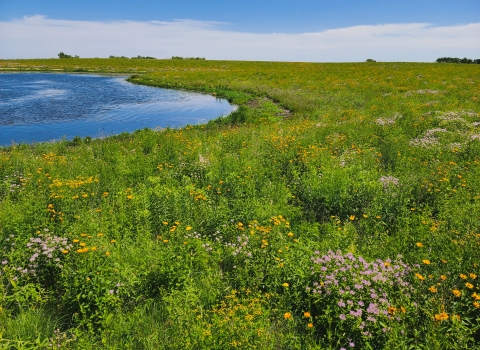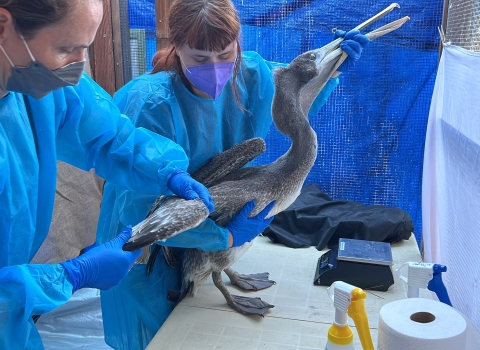LAKEWOOD, Colo. – The U.S. Fish and Wildlife Service (Service) is seeking public comment on a Draft Environmental Impact Statement (DEIS) for the Power Company of Wyoming’s (PCW) Chokecherry and Sierra Madre Phase I Wind Energy Project (CCSM). The DEIS evaluates the impact of issuing an eagle take permit for the 500-turbine project to be built south of Rawlins, Wyoming.
If fully developed, the project would be one of the largest land-based wind energy developments in North America, projected to produce enough electricity to power nearly 1 million homes. The DEIS assesses the impacts of the take permit, as well as mitigation and conservation opportunities. PCW’s Eagle Conservation Plan, which formed the basis for their permit application, is also available for public review as part of the DEIS.
“Renewable energy has the ability to reduce America’s carbon footprint and slow the rate of climate change climate change
Climate change includes both global warming driven by human-induced emissions of greenhouse gases and the resulting large-scale shifts in weather patterns. Though there have been previous periods of climatic change, since the mid-20th century humans have had an unprecedented impact on Earth's climate system and caused change on a global scale.
Learn more about climate change , benefiting humans and wildlife alike – including eagles. Yet projects of this size can impact wildlife and other natural resources in myriad and complex ways,” said Noreen Walsh, Regional Director for the Service’s Mountain Prairie-Region. “Our goal is to ensure that this and other wind energy projects proceed in a manner that balances renewable energy goals with conservation needs, and to avoid and minimize—to every extent possible—impacts to our eagle populations."
The Bald and Golden Eagle Protection Act prohibits the “take” of bald and golden eagles – defined as to pursue, shoot, shoot at, poison, wound, kill, capture, trap, collect, destroy, molest or disturb” – without permit. In 2009, the Service published a final rule authorizing take of eagle nests and the incidental (non-purposeful) take of eagles associated with an otherwise lawful activity.
The take permitting system enables the Service to work collaboratively and proactively with industry to avoid and minimize eagle deaths, ensure golden eagle take is mitigated, and gather essential information about eagles that will help to maximize their conservation across the nation. This process provides a mechanism for responsible companies to do the right thing and the ability for the Service to legally pursue those that kill eagles without a permit.
The public is invited to comment on whether the DEIS effectively analyzes the impacts that would result when avoidance and conservation measures are applied. The Service will host two informational open house meetings on the DEIS on June 6, 2016 in Saratoga and June 7, 2016 in Rawlins, Wyo. The Informational open house meetings will enable the public to ask Service employees questions about the DEIS and learn more about how the Service protects eagles and other migratory birds and wildlife species.
Locations:
June 6, 2016
Platte Valley Community Center
210 Elm St
Saratoga, Wyo.
4:30-6:30 p.m.
June 7, 2016
Jeffrey Memorial Community Center
315 W Pine St
Rawlins, Wyo.
4:30-6:30 p.m.
The Service will be publishing a notice of availability (NOA) for the DEIS in the Federal Register in the coming days. Once the NOA publishes, public comments will be accepted for 60-days. You will be able to submit comments electronically via email to ccsm-eis@fws.gov
Comments will also be accepted via U.S. mail or hand-delivery: Chokecherry-Sierra Madre EIS, U.S. Fish and Wildlife Service Mountain-Prairie Region, Attention: Louise Galiher, P.O. Box 25486 DFC, Denver, Colorado 80225
The mission of the U.S. Fish and Wildlife Service is working with others to conserve, protect, and enhance fish, wildlife, plants, and their habitats for the continuing benefit of the American people. We are both a leader and trusted partner in fish and wildlife conservation, known for our scientific excellence, stewardship of lands and natural resources, dedicated professionals, and commitment to public service.
Connect with our Facebook page at http://www.facebook.com/USFWSMountainPrairie, follow our tweets at http://twitter.com/USFWSMtnPrairie, watch our YouTube Channel at http://www.youtube.com/usfws and download photos from our Flickr page at http://www.flickr.com/photos/usfwsmtnprairie/.


